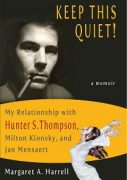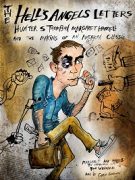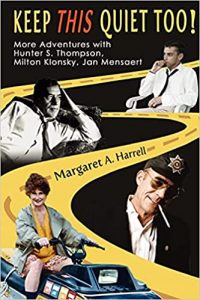“Denuding” Myself: A Path to Authenticity as a Woman
“Denuding” Myself
A Path to Authenticity as a Woman
You cannot swim for new horizons until you have courage to lose sight of the shore.
—William Faulkner
I have been involved in writing/editing/publishing all my life. Also, I love a wide scope, being a dual national, US/Belgian. To write my memoir about my New York City days, I got the strong advice to play it safe: focus on Hunter S. Thompson. He had the big name, and I had lots of inside information, having copy-edited his first book, Hell’s Angels, and had a romantic relationship with him. But that’s not what I envisioned. Once my next-door neighbor on Bleecker Street in Greenwich Village explained that when she came to New York, she “didn’t know how to talk.” Well, I didn’t either. Talking required being authentic. I coveted that trait, but to get to it, I had to cast aside an incredible self-consciousness. That’s where these three writers came in.

Keep This Quiet!
cover : Gaelyn Larrick
In my memoirs I decided to illustrate, narratively, how, at different poles, these three—Gonzo founder Hunter S. Thompson, poet/Blake scholar Milton Klonsky, and Belgian poet Jan Mensaert—exhibited authenticity; and interaction with them was vital to me in learning how to express it in myself. Of course, I didn’t outright say what I was doing. I let the reader figure it out. But it was why I was insistent, with myself, not to focus just on Hunter; for each of the three males covered a different facet of what was important to me: Milton with his poetic depth, his wise one-liner absorbed angles into reality; Jan with his wildness and refusal to be frightened; and, of course, Hunter, whom it was unforgettable just to be around, more so than his reputation would hint at.
Keep THIS Quiet Too! More Adventures with Hunter S. Thompson, Milton Klonsky, Jan Mensaert is the sequel to Keep This Quiet! My Relationship with Hunter S. Thompson, Milton Klonsky and Jan Mensaert. I followed Milton’s advice to “denude yourself,” that is, cast aside timidity; “I can dream as well as anyone.” The reviews bear out this intent to come clean with the reader: Keep THIS Quiet Too! is “a passionately written memoir that doesn’t sit around being fit and proper and strait-laced . . . As a key to the lives of these three writers it is idiosyncratic and in age where blandness is the norm, it is a pleasure to go on her journey and find out a little about what made these men tick and what drove her to them.”—Eric Jacobs, Beat Scene # 70. Writing in a non-strait-laced fashion was only possible by learning, no matter how hard it was, to be unself-conscious, trusting the story.
BookLife mentions “abundant enticing experiences and insights” and “a journey with grand destinations throughout the globe and within the author’s consciousness.” Also, “an eye for surprising detail” and “a charged and vivid milieu, even as the story she tells is often painful.” These types of input, a book needs a lot of.
Having writers for characters, I brought them into my books, including letter snippets and, in Milton’s case, actual quotations of his quippy, sage, deep advice to me that illustrated humor or fearlessness in the face of whatever came one’s way. And I didn’t just tell the reader why Jan’s artistry attracted me. I included some of his drawings.

Grant Goodwine’s drawing imagining the moment when Hunter andI Margaret met – part of a series of his illustrations in The Hell’s Angels Letters
Though it took years, I went from fear of confrontation to understanding how if you just step aside, not leading with the ego, there are all the answers and “connections” you could ever need within. It took me a long time to embody these beliefs, but I do and anybody can. And they are essential for a writer.
Another asset was, after my marriage ended, spending three years at the Jung Institute Küsnacht, Switzerland, learning about depth psychology. Once, I wanted to use a Jungian explanation for a scene in the book, letting me off the hook; my editor canceled that idea. “Margaret,” he said, “You can’t tell the reader what to think. So I left myself exposed to who knows what interpretation. Another time, this marvelous editor stopped short in reading to protest, “This has to be a scene.” Of course. It was when I first met Hunter in person. “But I don’t remember,” I said. On the contrary, he said, “Sit at the computer with a blank screen and just write.” You can do it. It worked.

The Hell’s Angels Letters cover: Grant Goodwine
Everything I write about, I learned in experiences, sealed with memories of unforgettable human beings. Follow your heart, “denude yourself,” I advise anyone, in writing or just living life.
Hunter’s letters did indeed, serendipitously, eventually attract a traditional publisher, Norfolk Press of San Francisco, to bring them out in a coffee table artbook by me in 2020/’21, The Hell’s Angels Letters: Hunter S. Thompson, Margaret Harrell and the Making of an American Classic (available at the Norfolk Press website).
Besides an author, I’m an editor, a meditation teacher (the light body), and a cloud photographer. I realized I could express myself in many directions by just staying open. But first, I had to sit my intuition down beside my thinking mind and let my thoughts test my intuition. Finding that it was solid, I then proceeded into new pathways, with both ways of getting information at my side. I welcome any feedback through https://margaretharrell.com.
—
The author of the four-book “Keep This Quiet!” memoir series, Harrell copy edited/assistant-edited Hunter Thompson’s first book, “Hell’s Angels,” at Random House. HST acknowledged her in “Gonzo Letters” 2. After graduating from Duke and Columbia universities, she studied at the Jung Institute in Zurich. She lived abroad many years, in Morocco, Switzerland, and Belgium. She is also an editor, cloud photographer, and light body meditation teacher, mentoring people trying to maximize their potential.
Follow Margaret on Twitter @MargaretAHarre4
KEEP THIS QUIET, TOO

Keep This Quiet! Too!
cover : Gaelyn Larrick
In this sequel to Keep This Quiet! Margaret relocates to Morocco with her exotic, fascinating, unstable Belgian poet husband, Jan Mensaert. Living in villages, she experiences cooking on charcoal and shopping for fresh groceries daily with a basket in open air markets. But the main focus is on her encounters with the three male protagonists, “outlaw” authors one and all, brilliantly creative and with the personalities that match. In once-yearly trips to the States, she re-energizes on a diet of one-liner advice, deeply digested and wise, from genius-poet Milton Klonsky.
This, she reports to the reader, magically as if her mind were a tape recorder. She also gets Gonzo updates from Hunter Thompson – two relationships that never lose their hold or significance, even necessity. From Morocco, to Belgium, to Switzerland, and the US, Margaret pits wits with – learns from – and grows through these close – sometimes romantic – relationships with men who exemplify authenticity.
At one point, trying desperately to find her, Hunter writes, “Dear Margaret, Where are you and why? I’ve lost track completely. My last definite word was from a toilet-hole in Algiers.” He wants her to work on his next manuscript. This is 1971. Moving from 1970 (Belgium/a Cairo honeymoon) to 1986 (the Jung Institute Zurich), the book ends up fittingly at Hunter’s Owl Farm. Where else could the last two chapters take place? There, she reintroduces herself to Hunter. In fine form, he is trying to take the romance to the next level.
Actually, they both are intent on it.
BUY HERE
Category: Contemporary Women Writers, How To and Tips






























